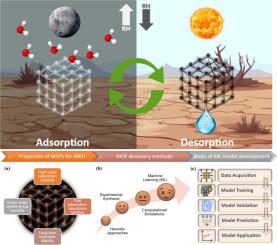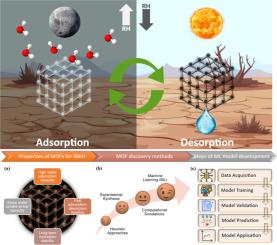用于大气集水的下一代mof:机器学习技术的作用
IF 23.5
1区 化学
Q1 CHEMISTRY, INORGANIC & NUCLEAR
引用次数: 0
摘要
利用金属有机框架(mof)进行大气水收集(AWH)已成为一种非常有前途的缓解水资源短缺的方法,特别是在干旱和半干旱地区。用于水处理的高性能mof的发展取决于具有最佳吸水能力、快速吸附-解吸动力学和强大水解稳定性的材料。然而,mof的结构复杂性和传统实验筛选的低效率使得数据驱动的方法,特别是机器学习(ML),对于加速材料发现越来越不可或缺。在应用于基于mof的AWH的ML技术中,随机森林(RF)、随机森林回归(RFR)、邻居成分分析(NCA)、遗传算法(GA)和机器学习原子聚类扩展(MACE)等模型表现出了出色的预测性能。这些模型特别有价值,因为它们能够捕获非线性依赖关系,提高可解释性,并优化跨不同应用程序领域的设计策略。这篇综述全面分析了ml辅助的AWH MOF发现,重点关注显式和潜在描述符的作用、评估指标、数据集管理挑战和比较模型性能。通过强调RF、MACE、NCA、RFR和GA的卓越预测能力,这项工作突出了ML在推动下一代mof的合理设计方面的变革潜力,以实现高效和可扩展的AWH。本文章由计算机程序翻译,如有差异,请以英文原文为准。


Next-generation MOFs for atmospheric water harvesting: The role of machine learning techniques
Atmospheric Water Harvesting (AWH) using Metal-Organic Frameworks (MOFs) has emerged as a highly promising approach to mitigate water scarcity, especially in arid and semi-arid regions. The development of high-performance MOFs for AWH hinges on materials that exhibit optimal water uptake capacity, rapid adsorption-desorption kinetics, and robust hydrolytic stability. However, the structural complexity of MOFs and the inefficiencies of traditional experimental screening have made data-driven approaches, particularly machine learning (ML), increasingly indispensable for accelerating materials discovery. Among the ML techniques applied to MOF-based AWH, models such as Random Forest (RF), Random Forest Regression (RFR), Neighbor Component Analysis (NCA), Genetic Algorithms (GA), and Machine-Learned Atomistic Cluster Expansion (MACE) have demonstrated outstanding predictive performance. These models are especially valued for their ability to capture non-linear dependencies, improve interpretability, and optimize design strategies across diverse application domains. This review presents a comprehensive analysis of ML-assisted MOF discovery for AWH, focusing on the roles of explicit and latent descriptors, evaluation metrics, dataset curation challenges, and comparative model performance. By emphasizing the superior predictive capabilities of RF, MACE, NCA, RFR, and GA, this work highlights the transformative potential of ML in driving the rational design of next-generation MOFs for efficient and scalable AWH.
求助全文
通过发布文献求助,成功后即可免费获取论文全文。
去求助
来源期刊

Coordination Chemistry Reviews
化学-无机化学与核化学
CiteScore
34.30
自引率
5.30%
发文量
457
审稿时长
54 days
期刊介绍:
Coordination Chemistry Reviews offers rapid publication of review articles on current and significant topics in coordination chemistry, encompassing organometallic, supramolecular, theoretical, and bioinorganic chemistry. It also covers catalysis, materials chemistry, and metal-organic frameworks from a coordination chemistry perspective. Reviews summarize recent developments or discuss specific techniques, welcoming contributions from both established and emerging researchers.
The journal releases special issues on timely subjects, including those featuring contributions from specific regions or conferences. Occasional full-length book articles are also featured. Additionally, special volumes cover annual reviews of main group chemistry, transition metal group chemistry, and organometallic chemistry. These comprehensive reviews are vital resources for those engaged in coordination chemistry, further establishing Coordination Chemistry Reviews as a hub for insightful surveys in inorganic and physical inorganic chemistry.
 求助内容:
求助内容: 应助结果提醒方式:
应助结果提醒方式:


